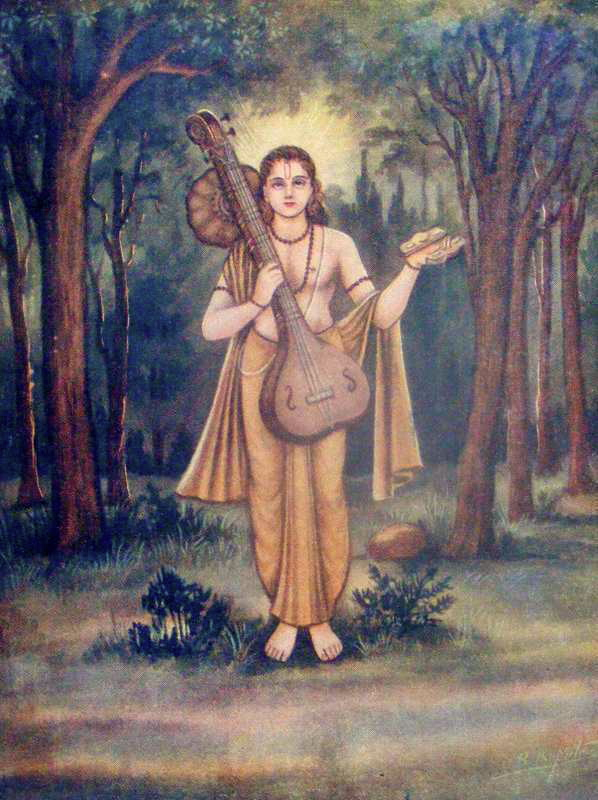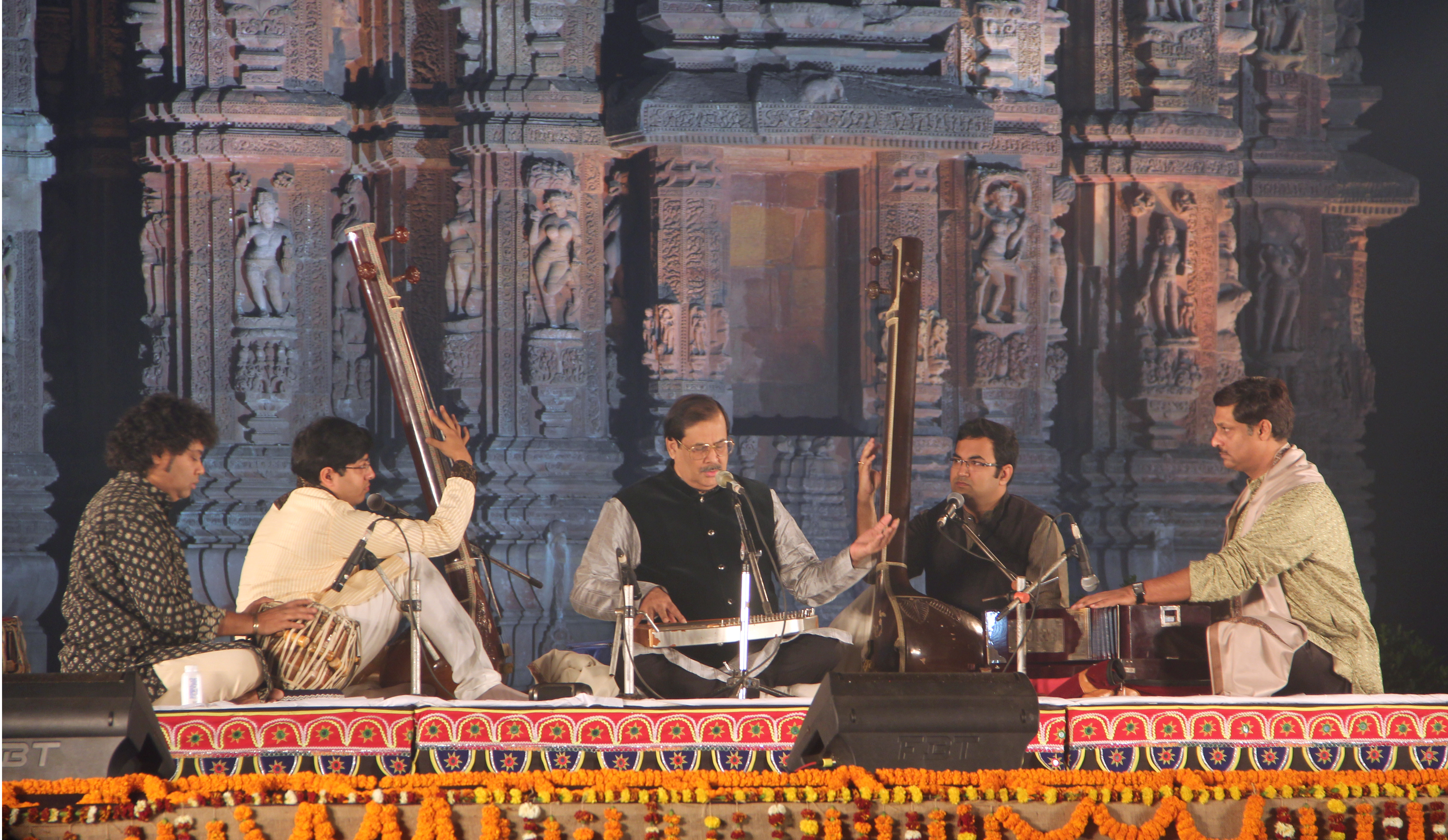|
Jhaptal
Jhaptal (Hindi: झपताल) is a '' tala'' used in Hindustani music. It presents quite a different rhythmical structure from '' teental'' in that it is not symmetrical. It is used in madhyalay (medium-tempo) khyal. Arrangement Jhaptal is a 10-beat pattern used in raga exposition. It has ten beats in four divisions (vibhag 'Vibhag' (in music) represents a duration of rhythmic phrasing in Indian classical music made up of a certain number of beats. They are the rough equivalent of bars in western music, but instead of always being equal subdivisions of the tala (the ...), of 2-3-2-3, the third of which is the khali, or open division. To follow the tal the audience clap on the appropriate beat, which in jhaptal is beats 1, 3 and 8 (the first beat in each full division). A wave of the hand indicates beat 6, the first beat of the khali section. Series of Claps and Waves: clap, 2, clap, 2, 3, wave, 2, clap, 2, 3 Theka There are 4 vibhags: The split for Jhaptaal : 2 / 3 / 2 / ... [...More Info...] [...Related Items...] OR: [Wikipedia] [Google] [Baidu] |
Tala (music)
A tala (IAST ''tāla'') literally means a 'clap, tapping one's hand on one's arm, a musical measure'. It is the term used in Indian classical music similar to Metre (music), musical meter, that is any rhythmic beat or strike that measures musical time. The measure is typically established by hand clapping, waving, touching fingers on thigh or the other hand, verbally, striking of small cymbals, or a percussion instrument in the Indian subcontinental traditions. Along with ''raga'' which forms the fabric of a melodic structure, the ''tala'' forms the life cycle and thereby constitutes one of the two foundational elements of Indian music. ''Tala'' is an ancient music concept traceable to Vedas, Vedic era texts of Hinduism, such as the ''Samaveda'' and methods for singing the Vedic hymns. The music traditions of the North and South India, particularly the ''raga'' and ''tala'' systems, were not considered as distinct until about the 16th century. There on, during the tumultuous ... [...More Info...] [...Related Items...] OR: [Wikipedia] [Google] [Baidu] |
Khyal
Khyal or Khayal (ख़याल / خیال) is a major form of Hindustani classical music in the Indian subcontinent. Its name comes from a Persian language, Persian/Arabic language, Arabic word meaning "imagination". Khyal is associated with romantic poetry, and allows the performer greater freedom of expression than dhrupad and is sung with the tabla instead of the pakhavaj. In khyal, ragas are extensively ornamented, and the style calls for more technical virtuosity. Etymology () is an Urdu word of Arabic origin which means "imagination, thought, ideation, meditation, reflection". Hence khyal connotes the idea of a song that is imaginative and creative in either its nature or execution. The word entered India through the medium of the Persian language, Persian language. Just as the word reflects ideas of imagination and imaginative composition, the musical form is imaginative in conception, artistic and decorative in execution and romantic in appeal.Francis Joseph Steingass� ... [...More Info...] [...Related Items...] OR: [Wikipedia] [Google] [Baidu] |
Vibhag
'Vibhag' (in music) represents a duration of rhythmic phrasing in Indian classical music made up of a certain number of beats. They are the rough equivalent of bars in western music, but instead of always being equal subdivisions of the tala (the rhythmic cycle - think 12 bar blues), they can be uneven. In certain traditions of talas in Tabla or in any other percussion instrument in classical music have Vibhagas to get a track of the beats on Matra (music)">Matras on which the singer or player is singing or playing on. For example taking different talas, Tala Teental has 16 matras in it. It has 4 Vibhags. So Teental with Vibhags is written as This can also be shown using the following figure If you see both the tables then you may realize that after every 4 syllables i.e. considering the 1st line so Dha Dhin Dhin Dha after this is a line like this , . This is the symbol of Vibhag. And after the 4 syllables Dha Dhin Dhin Dha is the Vibhag. Now it is simple Maths that if ther ... [...More Info...] [...Related Items...] OR: [Wikipedia] [Google] [Baidu] |
Hindustani Music
Hindustani classical music is the Indian classical music, classical music of the Indian subcontinent's northern regions. It may also be called North Indian classical music or ''Uttar Bhartiya shastriya sangeet''. The term ''shastriya sangeet'' literally means classical music, and is also used to refer to Indian classical music in general. It is played on instruments like the veena, sitar and sarod. It diverged in the 12th century Common Era, CE from Carnatic music, the classical tradition of Southern India. While Carnatic music largely uses compositions written in Sanskrit, Telugu language, Telugu, Kannada, Tamil language, Tamil, Malayalam, Hindustani music largely uses compositions written in Hindi, Urdu, Braj Bhasha, Braj, Awadhi language, Avadhi, Bhojpuri language, Bhojpuri, Bengali language, Bengali, Rajasthani languages, Rajasthani, Marathi language, Marathi and Punjabi language, Punjabi. Knowledge of Hindustani classical music is taught through a network of classical musi ... [...More Info...] [...Related Items...] OR: [Wikipedia] [Google] [Baidu] |
Teental
Teentaal (alternatively spelled tintal, teental, or tintaal, and also called trital; Hindi: तीन ताल) is the most common '' taal'' of Hindustani music, and is used for ''drut'' (fast tempo). It is symmetrical and presents a very simple rhythmic structure against which a performance can be laid. ''It is of 16 beats'' with 4/4/4/4/ pattern and 4 divisions.There are 3 claps(tali) and 1 gap(khali). Arrangement Teentaal has sixteen (16) beats in four equal divisions (Vibhag). The period between every two beats is equal. The first beat out of 16 beats is called ''sam'' and the 9th beat is called ''khali'' ('empty'). To count the Teentaal, the audience claps on the first beat, claps on the 5th beat, then waves on the 9th beat and lastly again claps on the 13th beat; these three claps (Hindi Modern Standard Hindi (, ), commonly referred to as Hindi, is the Standard language, standardised variety of the Hindustani language written in the Devanagari script. It is an of ... [...More Info...] [...Related Items...] OR: [Wikipedia] [Google] [Baidu] |
Bol (music)
A bol is a standardized mnemonic A mnemonic device ( ), memory trick or memory device is any learning technique that aids information retention or retrieval in the human memory, often by associating the information with something that is easier to remember. It makes use of e ... syllable used in North Indian classical music to define the tala, or rhythmic pattern. Bol is derived from the Hindi word ''bolna'' (बोलना), which means "to speak." One who learns to play the tabla or pakhavaj (or pakhawaj) drum is taught to recite the rhythms as bols, which can be quite complex. Bol is analogous to konnakol, which is used to recite rhythms for the mridangam drum in Carnatic music, which is South Indian classical music. See also * * * * References External linksKKSongs Talamala - Tabla Bol Referencehas recordings of tabla bols.Instruments in Depth: Tabla: Drums of North India an online feature froBloomingdale School of Music(March, 2008) contains detail ... [...More Info...] [...Related Items...] OR: [Wikipedia] [Google] [Baidu] |

